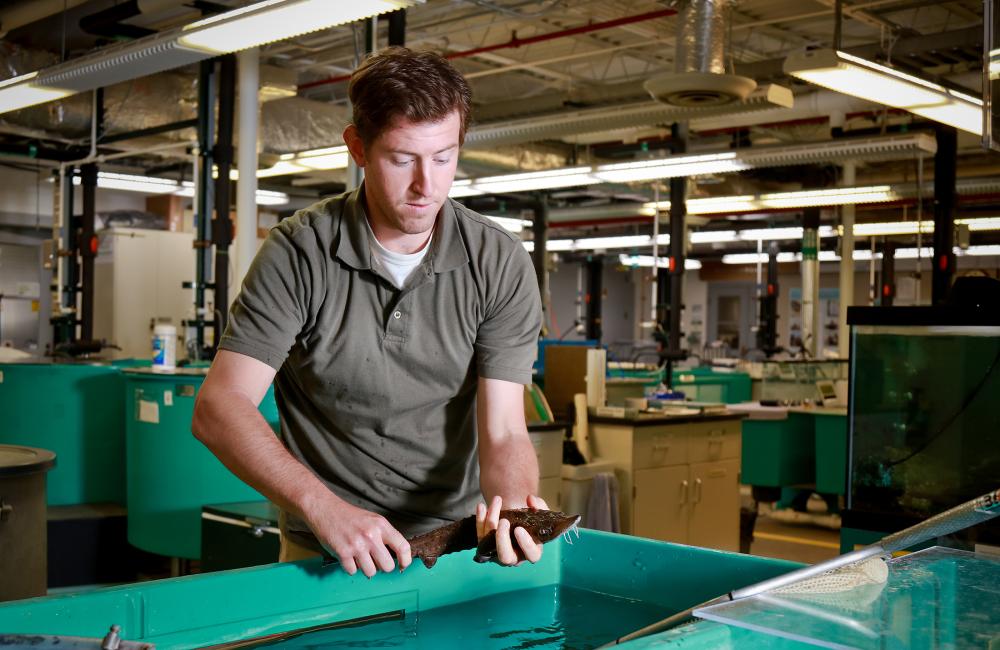June 27, 2017 – Growing up in South Carolina, Ryan McManamay enjoyed a nature-rich upbringing. Both of his parents are retired teachers from the public school system and instilled in him early an appreciation for immersive learning as well as a love of the outdoors.
His father, a biology teacher, was known for rigorous instruction and a classroom overrun with fascinating critters. “There were pacu and mudpuppies, all manner of mice, African frogs, a corn snake, and a beloved black rat snake named ‘Elvis.’ It was an engaging setting for high school students. So, naturally, everyone loved going to biology class,” McManamay recalled.
McManamay felt the pull of becoming a biology teacher like his father but was moved by the same spirit toward research in natural resources. Now an aquatic ecologist and research scientist at the Department of Energy’s Oak Ridge National Laboratory, McManamay works to mitigate the impacts of urbanization and hydropower generation on stream and river ecosystems.
Acclimated to the hot South Carolina summers and long days spent outside in his youth, McManamay took to field research like a fish to water. He started in agriculture. As an undergraduate at Clemson University, he became involved in soybean breeding. Long, hot days outside were plentiful. He developed an interest in water resources, conducting trout population surveys for the US Forest Service and working in Clemson’s fish behavior laboratory as an undergraduate. A summer job with Idaho State University solidified his interest in stream and river work.
“It was a formative experience. Our team ventured into the wilderness of the Snake River Basin and Great Basin to examine morphological and genetic differentiation between cutthroat trout populations. We drove to remote areas, camped, and hiked for miles to field sites where we collected fish with backpack electrofishing equipment. We took photos and fin clips for analysis. We even snorkeled in the Salmon River to observe juvenile salmon,” McManamay said.
Inspired by those snorkeling trips in Idaho, McManamay would later use underwater observation methods in his dissertation research at Virginia Tech on fish and wildlife conservation.
An interdisciplinary mindset
A growing interest in applied research ultimately led McManamay to ORNL. “Basic research in aquatic ecology compelled me toward restoration work and managing environmental flows. I wanted my findings to influence policy decisions and regulatory requirements to ensure healthy, sustainable ecosystems in an environmentally-conscious energy future,” he said.
After receiving his PhD in 2011, McManamay served as a post-doc at ORNL for two years. Since 2013, he has been a research scientist with the Aquatic Ecology group in the Environmental Sciences Division. Though he now spends more time behind the desk than outdoors, McManamay has found himself at home in the laboratory’s interdisciplinary environment.
“I consider myself an interdisciplinarian, and ORNL truly fosters research and collaboration across fields," he said. "It is a very challenging and stimulating atmosphere. You have the opportunity to jump into different areas and push the boundaries of your research.”
Transforming our energy future
In 2017, McManamay accepted his newest “challenge” to serve ORNL’s Urban Dynamics Institute (UDI) as theme lead for the Energy-Water Nexus, a research area focused on the dynamic relationship between energy and water systems. A city’s energy and water needs are closely intertwined. All energy production uses water, whether for hydropower generation or cooling operations in coal and nuclear plants. Water systems, in turn, require energy for treatment and distribution.
As part of his work with the UDI, McManamay leads a Laboratory Directed Research and Development project on the impacts of urbanization on river networks. The project examines both Atlanta and Knoxville, using high-resolution modeling to shed light on the far-reaching effects of metropolitan energy use on river systems, all the way to the river basin.
“We want to quantify the urban energy-water relationship in a meaningful way with the future aim of transforming these competing systems into complementary ones,” he said.
McManamay plans to launch a decision-support tool to help emerging cities be proactive about their energy futures. “We will need new approaches to power generation and a mix of conventional and alternative sources to transform our energy future, but cities will also need the information to support where those kinds of investments will be the most beneficial,” he said.
Ultimately, McManamay hopes to help reform urban policy. “We cannot sustain the current trajectory of growth, growth, growth,” he explained. “Cities are eventually going to have to rethink the way they use water resources and look for more efficient, environmentally protective approaches. In the US, 95% of the population lives in metropolitan statistical areas. In order to transform our energy future, change will have to come from the bottom-up, from the cities that are driving urban appetites for energy and water.”
UT-Battelle manages ORNL for the DOE’s Office of Science. The Office of Science is the single largest supporter of basic research in the physical sciences in the United States, and is working to address some of the most pressing challenges of our time. For more information, please visit http://energy.gov/science/.



